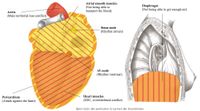Myocardium (heart muscle)
During evolution, the heart turned 180 degrees to make room for the lungs. As a result, here the mother-child side is the opposite side as the hand you clap with.
So for the right-handed person, the muscles of the right ventricle relate to the mother or child and those of the left ventricle relate to the partner or a third party.
Also see biological laterality.
For the general process, see muscles and muscle innervation.
Theme
Self Devaluation Conflict: I can't handle this, it's getting too much for me. Having too much going on, being overwhelmed.
CA phase
Decrease of heart muscle cells.
Symptoms
Usually unnoticed, possibly some fatigue.
Left myocardium: low(er) blood pressure, right myocardium: elevated blood pressure. Muscles of both chambers: fluctuating blood pressure.
With prolonged conflict: physical weakness, cardiac insufficiency, heart failure (usually the left myocardium).
PCL phase
Reconstruction of the heart muscle.
Symptoms
None, possibly some fatigue.
In syndrome: marked swelling sometimes interpreted as a myosarcoma (cancer of the heart muscle).
EC
Myocardial attack: epileptic seizure of the muscle of the left or right ventricle.
Symptoms
EC of the muscles of the left ventricle, distributing blood to the body (systemic circulation):
- Sudden drop in blood pressure
- Tachycardia, (high, irregular heartbeat)
- Fear and sense of destruction
- Absence or unconsciousness due to the innervation of the heart muscle from the motor cortex
- Apnea (interruption of breathing for more than 10 seconds) due to accompanying EC of the right diaphragm muscles and laryngeal muscles, which are functionally closely linked to the left heart muscle
- In severe cases: major biological shock
EC of the muscles of the right ventricle, sending blood to the lungs (pulmonary circulation):
- Suddenly elevated blood pressure
- Tachycardia, (high, irregular heartbeat)
- Fear and sense of destruction
- Absence or unconsciousness
- The left diaphragm muscles and the muscles of the bronchi are functionally closely linked to the right heart muscle. These are the most important muscles for breathing. Due to the accompanying EC in these muscle groups: apnea, breathlessness and a risk for respiratory arrest.
Therapy: cold water.
Biological purpose
The biological purpose is at the end of the PCL-B: stronger heart muscles, enlarged heart. Due to intense training: sporters heart.
Note
These programs do not involve cholesterol.
Clogging of the coronary arteries is thought to be the cause of myocardial infarction, but postmortem studies have shown that a large number of people did not have clogged coronary arteries.
These are frightening events, often with follow-up conflicts, such as "My heart is no good" (attack against the heart): pericardium.
If you have survived, the program is finalizing and no big problems are to be expected. The follow-up conflicts and the common perception of this crisis are the biggest problem.
Other forms of heart attacks: coronary heart attack, lung embolism.
Hanging healing: chronic cardiac arrhythmias.
More information during the online workshop Bio-logical Behavior and Character.
Diaphragm
Theme
Being physically overwhelmed, not being able to catch enough breath.
EC
Hiccups.

